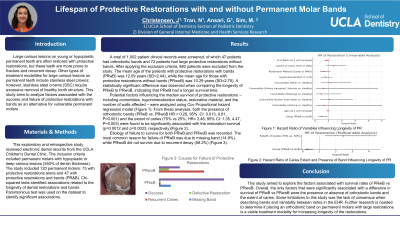Restorative
317 - Lifespan of Protective Restorations with and without Permanent Molar Bands

- JC
Jade Christensen, DDS
Pediatric Dental Resident PGY-2
UCLA Pediatric Dentstry
UCLA School of Dentistry Section of Pediatric Dentistry
Pasadena, California, United States - MS
Myung Sim, DrPH
UCLA Children's Dental Clinic
- NT
Nini Tran, DDS
Assistant Professor
University of Califronia, Los Angeles
Los Angeles, California, United States - GA
Ghassem Ansari, D.D.S., M.Sc., Ph.D., A.P.P.D
Clinical Professor
University of California, Los Angeles
Los Angeles, California, United States - NT
Nini Tran, DDS
Assistant Professor
University of Califronia, Los Angeles
Los Angeles, California, United States - GA
Ghassem Ansari, D.D.S., M.Sc., Ph.D., A.P.P.D
Clinical Professor
University of California, Los Angeles
Los Angeles, California, United States
Presenting Author(s)
Co-Author(s)
Research Mentor(s)
Program Director(s)
Purpose: Large carious lesions on young or hypoplastic permanent teeth are often restored with protective restorations, but these teeth are more prone to fracture and recurrent decay. This study analyzes factors associated with the success and failure of protective restorations with bands as an alternative for vulnerable permanent molars.
Methods: This exploratory and retrospective study reviewed electronic dental records from the UCLA Children's Dental Clinic. The inclusion criteria included permanent molars with hypoplastic or deep carious lesions (≥50% of dentin thickness). The study included 100 permanent molars: 50 with protective restorations alone and 50 with protective restorations and bands (PR&B). Chi-squared tests will identify associations related to the longevity of dental restorations and bands.
Results: Forty-seven teeth restored with protective restorations and bands (PR&B) were preliminary analyzed. The average age of the subjects whose molars were included was 11.2 years old, ranging from 8.3 to 17.7 years. Hypomineralization was observed in 26/47 teeth (55.3%). Reasons for band placement included fracture prevention in 25/47 teeth (53.2%), with only 6/25 (24.0%) bands placed after restorative completion. Recurrent caries accounted for 9/47 cases (19.1%), defective restorations for 2/47 (4.3%), and a combination of recurrent caries and defective restorations for 6/47 (12.8%).
Conclusions: The use of molar bands and temporizations is predicted to enhance the effectiveness of tooth-saving approaches.
Identify Supporting Agency and Grant Number:

.jpg)